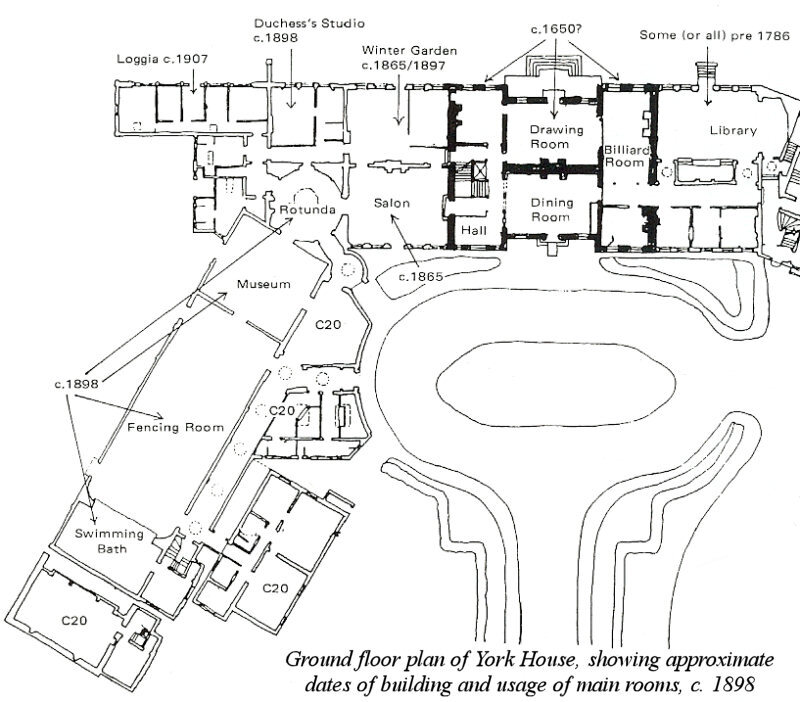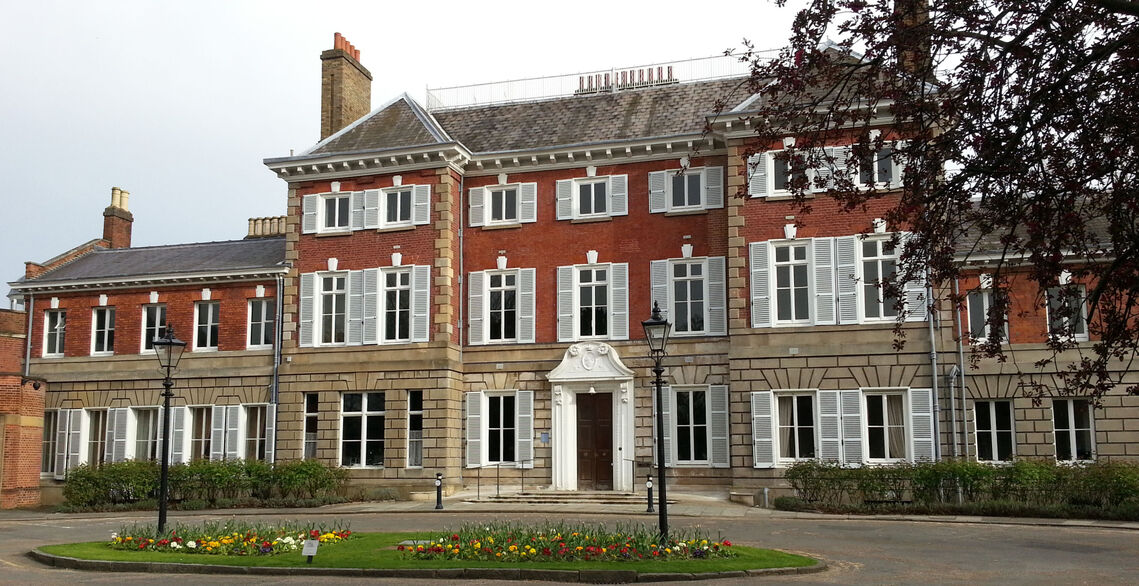In this section: A short history | The history of the house by Prof J M Lee | L'histoire en français
A Short History of the House
York House is Grade II listed and is scheduled as an ancient monument, dating back to the 17th Century.
The earliest reference to York House is in 1446, when it was known as Yorke Farm. This formed part of the Manor of Twickenham, which comprised 43 acres and 77 acres of common land in Twickenham, Whitton and Isleworth. At this date the farm was leased by William Helder and Walter Bolder to William Yorke and his wife Agnes.
In 1539, King Henry VIII created the Honour of Hampton Court, which included the Manor of Twickenham. Thereafter it formed part of the marriage settlement of Queen Henrietta Maria when she married Charles I. By 1551, King Edward VI had leased the house to Thomas Dover, his 'servant of le Pastorye', and later Queen Elizabeth I leased the farm to two members of her household.
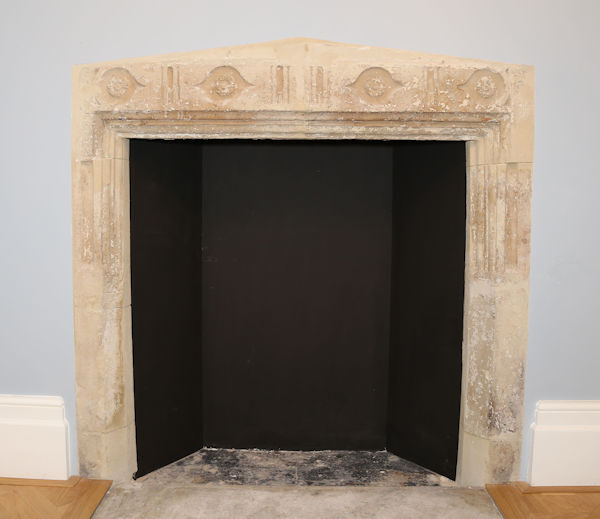 Photo courtesy LBRuT |
This Tudor fireplace was found during recent renovations. |
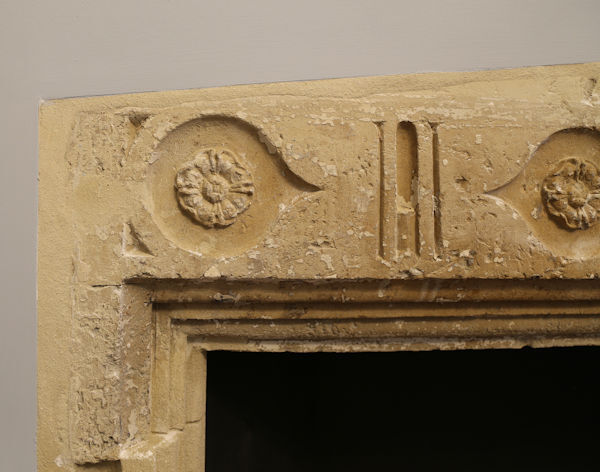 Photo courtesy LBRuT |
Detail of the fireplace |
In 1604, King James I granted a lease on Yorke Farm, which had then increased its enclosed land to 48 acres, whilst the amount of common land had been reduced to 71 acres.In 1634, the 'Hundred of Isleworth' map by Moses Glover depicts a building covered in scaffolding and surrounded by smaller structures in the position where York House stands today. This is believed to be the first documentary evidence of a house standing on the site. The then owners of Yorke Farm also owned the adjacent estate now known as Orleans House.
By 1635, Queen Henrietta Maria had granted Yorke Farm free, subject to a rent of £20, to William Scriven, Philip Eden and their heirs. The next year it was conveyed to Andrew Pitcairn, 'A groom of the Kings Chamber', but he died in 1640 leaving the property to his wife Charity.
Nikolaus Pevsner in his 'Buildings of England' believes that the next inheritor, the Second Earl of Manchester, probably built York House in the 1650's, although it was later remodelled in the early eighteenth century.
The next occupier was presumed to be Edward Hyde, Earl of Clarendon, who was believed to have acquired the property in 1661, but the deeds were held in the name of his eldest son, Henry. The Hyde family are credited with having rebuilt the house in the late 18th Century, creating an H-shaped Jacobean plan, whilst incorporating an earlier staircase. The core of the building is the original mansion of the 1630s (marked in black on the ground floor plan), which was then entered by a door in the north-eastern corner.
In 1639, the house had again been sold, this time to Sir Charles Tufton, for £3,000. The next occupant, who was thought to have much improved the house and the grounds, was Major James Webber, who occupied it prior to 1796. He was succeeded by Ludwig Count Von Starhemberg who built a theatre in the grounds which was attached to a wing of the house. There is no remaining evidence of the theatre and its exact location has never been established.
York House was then occupied by Archbishop Cleaver of Dublin, probably under a lease from Prince Starhemberg, from 1812 onwards. It was again sold in 1818 to Mrs Anne Damer, who had previously inherited Strawberry Hill from her godfather, Horace Walpole. Mrs Damer's contribution to the expansion of York House was to add a studio to the East end and also a conservatory, now demolished.
After Mrs Damer's death in 1828 until 1864, the house was let by her niece to various people. It was finally sold in 1864 to the Duc d'Aumale, who was at the time living at Orleans House. He purchased the property for his nephew the Comte de Paris, a grandson of King Louis Phillipe of France. Three of the Comte's children were born at York House and his daughter Marie Ameillie Louise Helen later became wife of King Carlos I of Portugal.
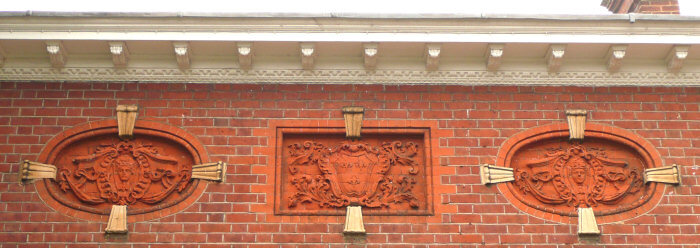
However, by 1871, the Comte left York House and returned to France, and the house stood empty until 1877, having been bought the previous year by Sir Montstuart Elphinstone Grant-Duff, the former governor of Madras. By November 1889, Duff had constructed several greenhouses, since demolished, in the gardens for the cultivation of orchids. These greenhouses were located in the grounds of the present York Cottage at the corner of Richmond Rd and Sion Rd.
The next owner in 1897 was the son of a previous owner, the Comte de Paris. Louis Philippe, Duc d'Orleans, had been born at York House in 1869. He bought the house for £13,000. He made extensive internal alterations and improvements and rebuilt the garden wall along the riverside.
The Duc left Twickenham in 1900 after he became unpopular for supporting the Boer cause during the Boer War, and retired to his uncle's estate at Wood Norton near Evesham.
In 1906 the house was sold by auction for £16,000 to Sir Ratan J Tata, an Indian merchant prince. His contribution towards the development of York House was to move the main entrance to the centre of the building and to build the loggia at the end of the East wing.
Sir Ratan Tata died in 1918 and his widow lived in York House until 1922 when she returned to India. In 1924 the property was purchased by Twickenham Urban District Council, who lent it to Twickenham Yacht Club. (The Yacht Club now uses what was the York House boathouse as their headquarters.)
When in 1926 Twickenham received its Charter of Incorporation, the borough decided to use the house for meetings. It was opened by the Duke of York, later King George VI.
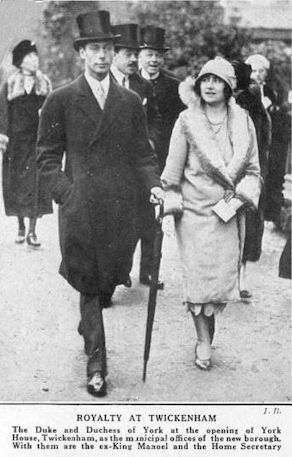 |
BFI film Twickenham's Town Hall From The Bystander 24 Nov 1926 Ex-King Manoel had been King of Portugal. His reign ended during the revolution of 1910 and he came to England with his mother, Amélie of Orleans, who was born in York House. |
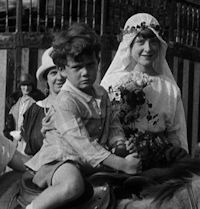 Charter Day, 1926. Photo © the BFI |
BFI film Twickenham: London's New Borough
|
To provide the Council with offices the ground floor has since been altered to accommodate a Council Chamber, Mayor's Parlour, Committee Rooms, cloakrooms and lavatories.
It was decided to use York House as the Municipal Offices when the London Borough of Richmond Upon Thames Council was formed in 1965.
See the Gardens page for the history of York House gardens and the story of the Naked Ladies.


